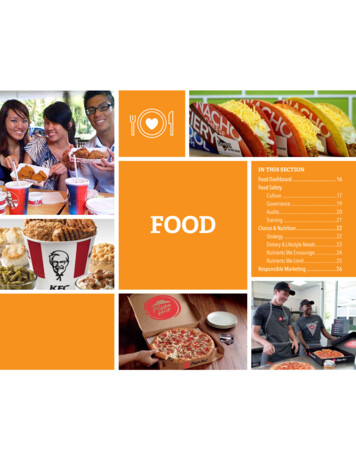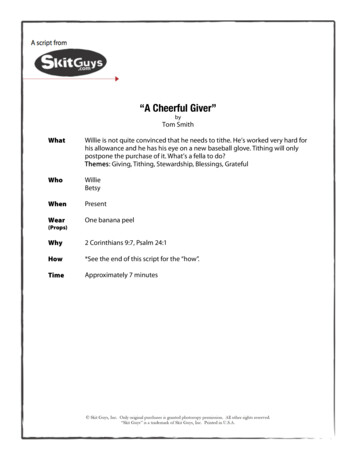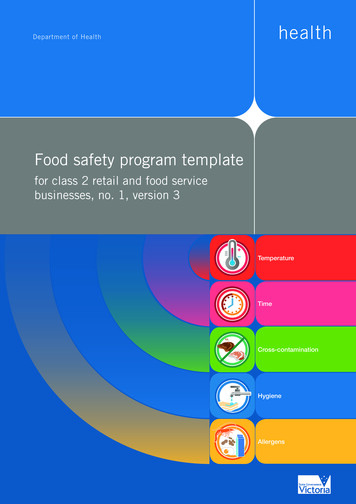
Transcription
IN THIS SECTIONFOODFood Dashboard. 16Food hoice & Nutrition. 22Strategy.22Dietary & Lifestyle Needs.23Nutrients We Encourage.24Nutrients We Limit.25Responsible Marketing. 26
FOOD DASHBOARDFOODWe Serve Food People TrustGOALSOPPORTUNITIES & CHALLENGESFOOD SAFETYMaintain an industry-leading, safe, high-quality foodsupply and customer experience.CHOICE & NUTRITION§§ Remove artificial colors and flavors from core foodingredients by 2020*§§ Remove all artificial trans fat from food ingredientsby 2020*§§ Offer 20 percent of meals consistent with one-thirdRecommended Daily Allowance (RDA) or foreignequivalents by 2020§§ Seek continuous improvements in the nutrition of ourfood that are aligned with the World Health Organization(WHO) to improve health and reduce chronic disease§§ Provide consumers with convenient access to foodinformation regarding menu labeling and allergensRESPONSIBLE MARKETINGLimit marketing communications to children under 12MATERIAL ISSUES§§ Food Safety§§ Nutrition§§ Responsible Marketing§§ Ensuring that food safety processes are aligned with an evolving,franchise-focused business model§§ Providing consumers with more access to balanced food choices thatare less processed or modified§§ Labeling menu offerings clearly and marketing responsibly to meetconsumers’ desire for increased transparencyKEY TAKEAWAYS§§ Food safety is our number one priority. A culture of food safety resonatesfrom the top down into our restaurants and among our franchisepartners and employees. Audits of our suppliers, distributors andrestaurants are conducted regularly.§§ Yum! Brands deployed a new global nutrition strategy that emphasizestransparency of ingredients, sodium reduction, simplified ingredientswith increased vegetarian, high-protein, lower-calorie, and otherofferings that promote a balanced diet.§§ Choice is important at Yum! Brands. We offer millions of menu itemsevery day and make it easy for consumers to customize orders to fittheir dietary and lifestyle needs.§§ We are committed to transparency and responsible labeling. Each of ourbrands publicly shares its nutritional profile, allergens and ingredients ofits core menu items, which consumers can easily access online.KEY STAKEHOLDERS§§ Consumers§§ Employees§§ Franchisees§§ NGOs§§ Suppliers*In key markets, excluding co-branded ingredients and beverages2 0 1 7 G LO B A L C I T I Z E N S HI P & S U STAIN AB ILITY RE P ORT16
FOOD SAFETYFOOD SAFETY CULTURETrust in Every BiteOur first priority — confirmed by stakeholders as part of the materiality assessment process —is to maintain an industry-leading, safe, high-quality food supply from farm to fork.Serving food that is prepared in a clean and sanitary environment, andhonestly presented, is a responsibility that we take seriously. To deliver onour vision of “Trust in Every Bite,” Yum! upholds an industry-leading foodsafety program and stringent food safety standards that mitigate foodsafety risks for consumers who visit our more than 45,000 restaurantsacross more than 135 countries and territories.Food safety starts with our leadership team and cascades to our franchisepartners and restaurant employees. Our approach is a holistic one, ensuringthat food safety is considered at every step along the supply chain.Our Food Safety Standards cover areas where key risk factors exist, such asemployee health and hygiene, product handling, product temperaturemanagement, cross-contamination and more. While these standards donot differ among brands, food safety risks do differ from brand to brandand across global markets.FARM TO FORK1 FARM2 PROCESSING§§ Supplier Audit Standards§§ Auditor Certification & Approval§§ Premiums§§ Produce Standards§§ Wholesome FoodAnimal Program§§ Regulatory Affairs§§ Crisis Management3 DISTRIBUTION§§ Supplier Audit Standards§§ Auditor Certification & Approval4 DELIVERY§§ Supplier Audit Standards2 0 1 7 G LO B A L C I T I Z E N S HI P & S U STAIN AB ILITY RE P ORT5 RESTAURANTS§§ Food Safety Facilities &Equipment Standard§§ Food Standards ComplianceCheck (FSCC)§§ Restaurant Food Safety Standards§§ Restaurant Pest Standard17
FOOD SAFETYSTAYING CURRENT ON EMERGING REGULATIONSYum! does not produce or manufacture ingredients in our food. Therefore,regulations that affect agricultural commodities and food products applymore directly to our local franchise partners, distributors or suppliers thanthey do to Yum!. We invest significant time and resources to validate thatour distributors and suppliers meet and comply with applicable regulationsand stringent food safety requirements set forth by Yum! and the industry.For example, the U.S. Food Safety Modernization Act (FSMA) impacts ourbusiness in several ways that have resulted in suppliers making significantfood safety changes, as well as countries revising their food codes. Wework closely with distributors, importers and suppliers in these locationsto make sure they will be compliant by FSMA enforcement dates.We believe that proactive food safety and quality assurance requiresmaintaining a constant cycle of reviewing and modifying standards,introducing and deploying new systems, improving upon existing systems,coaching and compliance monitoring, and staying current on emergingfood safety risks. As part of this commitment to continuous improvement,we conduct regular risk analyses and benchmark against other organizationswithin the restaurant industry to advance our food safety standards ina controlled, data-driven, proactive and scientific way. We closely trackcurrent and emerging food safety issues that affect our business. If changesoccur in food safety regulation, science or technology, we immediatelyassess issues and adjust our strategy accordingly.ENGAGING GLOBAL STAKEHOLDERSIn the U.S., we engage with stakeholders, such as the Food and DrugAdministration (FDA), Centers for Disease Control and Prevention (CDC)and state health departments, to verify our food safety managementapproach is aligned with their expectations and to build their knowledgeof Yum!’s food safety programs. In addition, Yum! influences state healthdepartments to adopt the model U.S. FDA Food Code. This enablesconsistent execution of science-based food safety practices to protectconsumer health and mitigate risks. Outside the U.S., Yum! and ourfranchisees also engage with regulators and policymakers in theirrespective markets.“ Effective management of food safetyrisk starts with a tremendous cultureof awareness about the primacy of foodsafety and expectations for high personalbehavioral standards — all supported bystrong restaurant surveillance routinesand appropriate levels of training on aconstantly refreshed basis.”CLIVE NEWTON — Yum! Chief Food Safety OfficerWe intentionally engage other companies and suppliers in our industryto help build a collective culture of food safety and share best practices.As an example, for the past seven years Taco Bell has hosted a meetingof industry peers on emerging issues in food safety. The meeting isheld during the Produce Marketing Association’s annual gathering,making it easy for companies to attend. Among the invited speakershave been experts on foodborne illness law and representatives fromthe United States Department of Agriculture (USDA) and CDC. By sharingknowledge with others, we position ourselves as a leader and elevatefood safety practices industrywide.2 0 1 7 G LO B A L C I T I Z E N S HI P & S U STAIN AB ILITY RE P ORT18
FOOD SAFETYFood Safety GovernanceCreating Broad AccountabilityAs we have transformed our business to a predominantly franchisedmodel — operating fewer company-owned restaurants in fewer markets— we have also adapted our food safety governance processes. We focuson putting the right people with the right capabilities in place at the globalbrand level so that individual business units can empower franchisepartners with clear metrics, goals and resources to successfully integrateour food safety policies and standards and deliver on our complianceprograms. This transition means that our franchise partners have moreresponsibility to communicate our brands’ food safety requirementsto their organizations as they make sense for their situation.FOOD SAFETYGOVERNING BODIESOur food safety governing bodies certify that regulatory compliance, legal requirements and Yum!’s policies andstandards for food safety are met and maintained by franchise partners, suppliers and local business unit teams.BOARD OFDIRECTORSAudit CommitteeResponsible for:§§ Risk Management§§ Annual ersight CommitteeThe Yum! executive groupresponsible for:§§ Maintaining oversight ofrisks including food safetyand other enterprise risksOPERATIONSCOMPLIANCEGlobal Food Safety CouncilA group of senior food safety,operations and supply chainleaders led by our ChiefFood Safety Officer. Theirresponsibilities include:Internal Audit TeamResponsible for independentlyevaluating the adequacy andeffectiveness of:§§ Food Safety Policies§§ Compliance with Yum!Policies & Procedures§§ Food Safety Standards§§ Quality Assurance§§ Processes & MeasurementSystems§§ Yum!’s Internal ControlProcesses§§ Compliance with Food SafetyLaws & Regulations§§ Awareness InitiativesAround New Food SafetyScience§§ Emerging Best Practices inRisk Mitigation2 0 1 7 G LO B A L C I T I Z E N S HI P & S U STAIN AB ILITY RE P ORT19
FOOD SAFETYRESPONDING EFFECTIVELY TO CRISISThe Yum! Brands Crisis Management Program is dedicated to anticipating,identifying and managing potential emerging food safety issues at thelocal, regional and global levels to protect the health and safety of ouremployees and consumers. In the event of a crisis, such as foodborneillness or product contamination, Crisis Core Teams (CCTs) are immediatelyactivated to support the restaurant, franchisee or business unit. CCTs areidentified proactively before a crisis event occurs and each member knowstheir role and responsibility during an active crisis.Key leadership and decision-makers receive training to become CCTmembers as part of Yum! Brands Crisis Management Program. Ouronline crisis training course and web application tools allow CCT membersto quickly identify and successfully manage crises within the Yum! Brandssystem. This crisis training is regularly reviewed and updated by internaland external stakeholders, including medical and epidemiology experts,based on new and emerging food safety science and best practices.Most of our franchise partners have defined crisis management teams,crisis response procedures and crisis communication plans that clearlyoutline how to communicate with their business unit and brand andwhat actions to take to mitigate a food safety issue.When it comes to communicating about a crisis with the public, wemaintain a Global Crisis Communications Repeatable Model that servesas a playbook for responding swiftly and with care. An important aspectof our approach is listening for and responding to crises on social media.Our global social media monitoring system — the Social Hive, along witha community outbreak detection program — is active 24-hours-a-day,seven-days-a-week and serves as an early warning system. The SocialHive tracks all mentions of Yum!, KFC, Pizza Hut and Taco Bell in morethan 45 languages. This system also alerts the appropriate contactsif potential issues surface and assists in intelligence-gathering andcommunications planning.Food Safety AuditsCreating Safety through OversightOur food safety auditing program is designed to promote effective control and riskmitigation throughout our global supply chain.Supplier and distributor audits are conducted by certified auditors whoundergo training and calibration. Auditors must be able to accurately andcompetently conduct food safety audits to minimize scoring variabilityand instill trust within the audit process.We select our suppliers based on audit performance, risk assessments,people capability and key performance indicators for food safety preventivecontrols, including Good Manufacturing Practices (GMPs), Hazard AnalysisCritical Control Point (HACCP), pest control, sanitation, operations and facilitymanagement, recall/withdraw plans and protection from contamination.Our Supplier Tracking Assessment and Recognition (STAR) qualitysystem facilitates a collaborative exchange of food safety informationamong suppliers, distributors and the franchisee community toprovide compliance and performance visibility. Each Yum! divisionquality assurance team manages food safety and quality monitoringof suppliers in both our processing facilities and our restaurants.The auditing plan and audit visit frequency for each supplier depends on theresults of our supplier risk assessment, performance level and perceivedrisk factors, including people and food safety capabilities. Suppliers thatare audited receive feedback on their performance to drive continuousimprovement and mitigate risk from defined food safety hazards. Eachyear, Yum! conducts approximately 3,000 food safety supplier audits.Suppliers are also subject to quality systems audits that verify theirsystems and processes meet Yum! or legal standards for food safetyand/or quality. Our distributors are subject to the same standards andexpectations of food safety as our suppliers and receive distributionaudits that cover transportation and warehouses.2 0 1 7 G LO B A L C I T I Z E N S HI P & S U STAIN AB ILITY RE P ORT20
FOOD SAFETYThird-party food safety professionals conduct Food Standards ComplianceCheck audits at our restaurants twice per year at a minimum to promotecompliance with our food safety standards and local regulatory requirements.In addition, restaurants must meet facility and equipment standards forhygienic and food-safe restaurant design. In 2017, more than 80,000restaurant food safety audits were completed across more than 45,000restaurants, bringing the total number since 2015 to over 230,000 audits.Food Safety TrainingEngaging Every Employee on Food SafetyEmployees are integral in maintaining the highest food safety standards in our restaurants.Every Yum! division has technical and leadership capabilities in foodsafety to actively manage and effectively execute Yum! Food SafetyPolicies and Standards, and all Yum! restaurant employees are trainedin food safety. Our Food Safety Standards set minimum requirementson the safe production of food using science-based data and regulatoryrequirements as a foundation. These standards guide employee trainingand are prepared in collaboration with food safety and quality assuranceexperts from across our organization so that food safety is consistentlyexecuted across our brands.All restaurant employees worldwide receive food safety training as partof the onboarding process, as well as regular, recurring food safety training.This instruction focuses on illness prevention, personal hygiene, handwashing, temperature management and more.YUM! PRODUCE SAFETYADVISORY COUNCILThe Yum! Produce Safety Advisory Council, an internaladvisory group led by Taco Bell which continues tobe an industry leader in produce safety, is made upof independent academics, competitors, suppliers,microbiologists, entomologists and other industryexperts to share best practices and the latest scienceand technology in food safety in produce. The councilbrings these stakeholders together and asks, “Whatare we doing now, how can we do it better and whatcan we do collectively in the future to keep the producein our supply chain safe?”2 0 1 7 G LO B A L C I T I Z E N S HI P & S U STAIN AB ILITY RE P ORT21
FOOD CHOICE & NUTRITIONCHOICE & NUTRITIONMaking Progress on NutritionYum! Brands listens to our consumers, so we know they want options that can help themcreate balanced meals when visiting our restaurants. We’re sharing more information thanever before about where our food comes from, what goes into it and how it’s made.One of the most material aspects of our business is to provide optionsthat fit a diverse range of lifestyles, eating habits and preferences acrossthe more than 135 countries and territories that we serve, all whilekeeping in mind a balanced diet. Yum! defines a balanced diet as thatwhich contains a wide variety of foods, including grains, rice andcereals, vegetables, dairy, meat and beans, fats, fruits and optionalcalories from sweets.Our team of expert nutritionists and food innovation professionals drivethe strategy for nutritious choices and ingredient improvements acrossKFC, Pizza Hut and Taco Bell. This strategy focuses on making our productsmore balanced, giving customers choices and being transparent aboutwhat’s in our food. While each brand has its own nutrition standards andaccountability plans, we are working toward consistency in the nutritionalquality of our food with new Global Nutrition Standards and Guidelines.LISTENING TO CONSUMERS’ CHANGING NEEDS AND HABITSFood- and diet-related illnesses are on the rise, resulting in growingconsumer awareness and concern about what they eat. This and otherfactors are changing consumers’ eating habits, needs and desires ata rapid pace. We conduct regular market research to ensure that ourbusiness is aligned with these shifts in preference and lifestyle. As abaseline, we know our consumers want safe, quality food that doesn’tcompromise on flavor. Current trends and considerations that we aretracking closely include:§§ Value: Our consumers seek delicious food that is affordable. Whilethey want nutritious options on our menus, they expect those optionsto be offered at a value.§§ Snacking: People are snacking more often and eating smaller portionsthroughout the day. Our brands are actively working to make our menusmore customizable, so if a consumer wants a convenient snack insteadof a full meal, they have plenty of options from which to choose.§§ Plant-Forward and Simple: Consumers are looking for ways toincorporate more plants (fruits, vegetables, whole grains) into theirdiets as well as options that are less processed. We are dedicated toincorporating fresh produce into our menus wherever possible andsimplifying ingredients across all our brands.§§ Gen Z: When it comes to the now-adolescent generation — “Gen Z”— and food, they aren’t just simply thinking about healthy diets andsimpler, fresher ingredients. They are also considering what foodmeans to them personally, for society and for the planet. Gen Z isasking the tough questions such as, “How will the food choices I makeimpact me and others? Where do the ingredients in my meal comefrom and how are they grown?” Gen Z is focused on the experience ofwhat they eat and making sure that it not only tastes good, but that ittranslates to positive impact.§§ Flexitarian Lifestyles: Consumers are trying to eat better, butthey also want choices that leave room for indulgence. One day,for example, a consumer might be in the mood for a vegetarianchoice, and the next, his or her main priority may be getting ahigh-protein meal. We make sure to provide a range of nutritiousoptions that accommodate the increasingly flexible eating habitsof our consumers.“ The theme we’re seeing with consumers isthat they want to eat better — but they alsowant choices. It’s all about finding a balancebetween healthy options and indulgence.We want to offer menu items that providechoices for everyone and every mood.”LIZ MATTHEWS — Taco Bell Global Chief Food Innovation Officer2 0 1 7 G LO B A L C I T I Z E N S HI P & S U STAIN AB ILITY RE P ORT22
FOOD CHOICE & NUTRITIONDietary & Lifestyle NeedsWe help consumers “hack” our menus to customize their order to fit their dietary and lifestyle needs.For instance, Pizza Hut allows every customer to customize their pizza with a variety of crusts and toppings. With Taco Bell’s Fresco Menu, consumers can easilyreplace standard ingredients with lower-calorie options and at participating KFC restaurants consumers have the choice of grilled chicken over fried chicken.High-Protein§§ Protein-centric menu with chicken§§ Provides high-protein offerings across 40 percent §§ Power Menu includes high-protein bowlsbreasts, drumsticks, whole wings, thighs,of its permanent core pizza and wings menuand burritos under 510 calories and overstrips and other options, including grilleddomestically and internationally20 grams of lean proteinchicken, at participating restaurantsVegetarian§§ Vegetarian meals can be made outof out of a number of delicious sides,while vegans can choose from corn,potato wedges or, in the U.S.,green beans§§ With a range of four to eight vegetables astoppings, Pizza Hut offers a variety ofvegetarian options that can account for morethan 30 percent of its permanent core offerings.In certain countries like India, vegetarianoptions account for more than 50 percent ofthe menu. Examples of vegetarian core pizzasare Cheese Lovers, Veggie Lovers and CreateYour Own combinations, where consumers canchoose a wide variety of fresh vegetables forpizza toppings or at our salad bar.Made Without §§ Sides and dressings, including green §§ Gluten-free pizza made with Udi’s Certifiedbeans, mashed potatoes, corn and coleGluten-Free crust and select gluten-freeGluten*slaw made without glutenLearn moretoppings§§ First quick-service restaurant to becertified by the American VegetarianAssociation (AVA)§§ 13 AVA-certified vegetarian menu items§§ 38 vegetarian ingredients (28 of whichare vegan)§§ Over 8 million vegetarian customizablecombinations§§ 36 ingredients made without glutenLearn more§§ Cheese-only and cheese-and-pepperoni glutenfree pizzas are prepared using procedurescertified by the Gluten Intolerance Group§§ Markets that have launched gluten-free pizzasinclude Australia, Canada, the U.K. and the U.S.Customizable§§ Kentucky Grilled Chicken atparticipating restaurants as analternative to the traditional friedoptions (and many internationalmarkets offer salads)§§ Meals can be tailored with a variety oftasty sides§§ “Create Your Own” menu has nearly endlessdifferent topping combinations, including avariety of crusts, cheeses, sauces, vegetables,fruits and proteins§§ WingStreet Wings can be customized witheight different flavors§§ Almost any item can be customized to“Fresco Style”§§ Power Menu allows for customizingto incorporate lean proteins andnutrient-rich produce§§ All menu items can be customized to fit§§ Pizza Hut U.S. developed a Restaurant Qualitywithin someone’s lifestyleFood Microsite at restaurantquality.pizzahut.com §§ Make it Meatless by replacing meat withto promote increased transparency and choicebeans on almost any menu item* Yum! Brands foods are not certified “gluten-free,” nor do we claim to be gluten-free across our brands. Special menu items made without gluten are available in the U.S. only.TACO BELL’S “FOOD FOR ALL” JOURNEYTaco Bell’s “Food for All” journey aims to create a menu that offers the choicesits consumers are asking for — from low-calorie and vegetarian to high-protein.Learn more about the Food for All journey in this video.Watch video2 0 1 7 G LO B A L C I T I Z E N S HI P & S U STAIN AB ILITY RE P ORT23
FOOD CHOICE & NUTRITIONNutrients We EncouragePromoting Nutrition While Delivering on TasteWe encourage balanced options, while still offering food that delivers on flavor and craveability.Our product development teams and suppliers follow nutrition and ingredient guidelines when beginning new product development.These guiding principles help to ensure that new menu items meet our nutrition targets and standards where possible. We also continue toexpand menu offerings with more gluten-free, fruit- and vegetable-forward, lower-calorie and high-protein menu items and ingredients.§§ A variety of vegetable sides are offered, including green beans, mashed potatoes, corn andcole slaw, each containing 10 grams of fat or less per serving.§§ In the U.S., KFC continues to explore opportunities for improving the nutritional makeup ofkids’ meals. The brand now offers a variety of kids’ meals under 300 calories.§§ KFC in the U.K. and Ireland has a suite of lighter menu options, including its Rice Box menuline that replaces fries with rice.Kentucky Grilled Chicken and green beans§§ Participating KFC restaurants offer Kentucky Grilled Chicken (KGC) for consumers looking forproducts that are lower in calories, depending on the size of the piece. More specific nutritionalinformation can be found here about KGC in the U.S. and here about KGC in the South Pacificand Africa regions.§§ KFC Australia has developed a Honey Mustard Baked Tender Twister that is lower in calories, fatand sodium to meet specific nutrition criteria.§§ Select international markets will launch a new “artisan” crust and new topping combinationsthat offer more vegetables and fresh ingredients by 2019.§§ In 2017, Pizza Hut U.K. launched vegan cheese options as well as gluten-free pizzas — optionswhich were already offered in Australia, Canada and the U.S.Udi's Gluten-free Pizza at Pizza Hut§§ The brand offers a salad bar and delivery salads packed with fresh produce in almost everycountry around the world.§§ Nearly three-quarters of menu items are less than 500 calories, and over half of Taco Bell’sbreakfast menu is less than 400 calories.§§ Ordering “Fresco style” replaces cheeses, mayo-based sauces, reduced-fat sour cream andguacamole with freshly prepared pico de gallo, at no additional cost. This switch can provideabout a 25 percent reduction in fat. The signature Fresco Menu offers seven items with lessthan 350 calories and 10 grams of fat.Taco Bell’s 7-Layer burrito§§ The Power Menu includes high-protein burritos and bowls, all under 510 calories.§§ Taco Bell is the first quick-service restaurant to offer menu items certified by the AmericanVegetarian Association.2 0 1 7 G LO B A L C I T I Z E N S HI P & S U STAIN AB ILITY RE P ORT24
FOOD CHOICE & NUTRITIONNutrients We LimitSimplifying Our IngredientsOur nutrition strategy focuses on simplifying ingredients by removing artificial flavors, colors,preservatives and additives such as trans fats, reducing sodium and lowering calories and fats.We’ve made measurable progress toward our goals to eliminate 100 percentof partially hydrogenated oil, artificial flavors and artificial coloring by 2020.In 2017, based on data representing 75 percent of our global restaurantcount, an estimated 97 percent of food items were free of partiallyhydrogenated oil, an estimated 70 percent were free of artificial flavors,and an estimated 78 percent had removed artificial coloring.A major focus area has been reduction of sodium across our brands.Currently, 15 percent of Pizza Hut pizzas have just one-third of the dailyrecommended dietary allowance for sodium, and 20 percent of itspizzas will meet that criteria by 2020. Over the last five years, Pizza Huthas lowered the sodium content in all its core dough crusts globally by25 percent, the lowest point possible without affecting functionality, asNOARTIFICIALTRANS FATS(KFC U.K.)NOMSG, BHA/BHT OR HIGHFRUCTOSECORN SYRUPNOARTIFICIALFLAVORS &COLORSwell as lowering the sodium content in its cheeses globally by between25 and 35 percent. Pizza Hut has provided country business units theoption to choose between standard and low-sodium options, andmarkets in Asia, Australia, Canada, Europe and Korea have opted in.Since 2008, Taco Bell has reduced sodium by 15 percent on averageacross the menu, the equivalent of 1.5 million pounds of salt removedeach year from consumers’ diets. By 2025, Taco Bell will expand thatcommitment to an additional 10 percent, for a total of 25 percentsodium reduction across the menu and is well on its way to achievingthis goal. Meanwhile, KFC works with suppliers and nutrition experts tofind opportunities to reduce sodium in its menu items where feasible.§§ In the U.S., all KFC menu items are free of food dyes (with the exception of beverages and third-party products). In addition,artificial colors and flavors will be removed from our core products by the end of 2018.§§ KFC U.K. products are free of artificial trans fats. The brand in the UK met its goal of removing artificial colors and flavors fromits own brand ingredients by 2017.§§ KFC China launched a new mayonnaise recipe for burgers that reduced fat content from 70 to 35 percent.§§ Since 2010, KFC Australia has worked across its core menu offerings to reduce sodium, and in 2012 changed its cooking oilfrom sustainably sourced palm oil to locally sourced high-oleic canola oil, and also introduced side salads options as well aspermanent grilled/baked menu choices. KFC Australia continues to look for ways in which it can make further improvements.§§ KFC Australia products are free from artificial trans fats and is working to remove all artificial colors and flavors by the end of 2018.§§ In 2015, Pizza Hut U.S. became the first national pizza company to remove artificial flavors and colors from its core pizzasand WingStreet products, and is committed to the same goal internationally by 2018. As of 2017, Pizza Hut had removedapproximately 72 percent and 78 percent of artificial flavors and coloring, respectively, from all food ingredients.§§ Pizza Hut domestically and internationally has eliminated partially hydrogenated oils (PHOs) from its entire menu. Pizza HutU.S. has eliminated MSG from its core menu and BHA/BHT from pepperoni.§§ Pizza Hut U.S. adds no sugar or oil to its pizza marinara sauce, and its cheese is made from 100 percent whole milk mozzarella.§§ In 2015, Taco Bell removed all artificial flavors and colors, replacin
safety program and stringent food safety standards that mitigate food safety risks for consumers who visit our more than 45,000 restaurants across more than 135 countries and territories. Food safety starts with our leadership team and cascades to our franchise partners and restaurant employees. Our approach is a holistic one, ensuring










